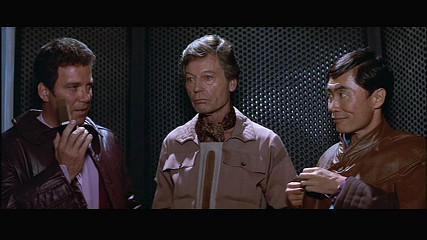
Star Trek III continues the story line from the second movie, with the Enterprise limping home after doing battle with the evil Khan. Unfortunately they are now short one crew member, Spock, who gave up his life to save the Enterprise. As he put it, "the needs of the many outweigh the needs of the few, or the one". Dr. McCoy, who was one of the last to see Spock, is slowly going mad, with what his crewmates believe is profound grief over the loss of his friend. But the unexpected visit of Sarek, Spock’s father, provides the startling revelation that Spock’s soul may still be alive. The problem is that Spock is buried on the Genesis Planet, and Starfleet has decided to scrap the Enterprise in favor of the newer Excelsior.
When Admiral Kirk requests a ship to return to the planet to retrieve his friend’s body so that he may be restored, Starfleet refuses – but Jim won’t have any of that. With the help of his crew they hijack their own decommissioned ship and head off at top speed towards the quarantined – and now self-destructing – Genesis Planet. Close by, the Klingons have learned of the Genesis Project’s deadly potential and want it for themselves. When Kirk arrives, the battle will not only be for the balance of power in the galaxy, but for both the life of his dearest friend... and his son. "The Search for Spock" is one of the more varied Star Trek movies, with a larger look at Roddenberry’s diverse universe. Directed by Leonard Nimoy, it closely follows the serious science-fiction style of the previous movie, while still providing some memorable humor. One of the more interesting surprises is the casting of Christopher Lloyd (Back to the Future) as Kruge, Kirk’s nemesis.

The new anamorphic transfer is quite respectable. The 2.35:1 widescreen presentation provides good color saturation throughout. Although it starts off with a moderate amount of dirt and lint, it quickly clears up. Details are sharp and black levels are well calibrated with excellent shadow detail. Film grain is much reduced over the previous movie, and the resulting image is smooth without too much aliasing. The single-layered disc does not require a layer change, but is divided into a mere 11 chapters with a total of 4.4 gigabytes of data. English subtitles and closed captioning information are provided.
Star Trek III has been treated to a brand new Dolby Digital 5.1 mix, which presents an excellent full soundstage. The rear channels are used quite often for James Horner’s orchestral score and numerous ambient effects, but rarely in an imposing manner. Bass is prevalent throughout the entire film, particularly when the cast is on the planet surface. Dialogue is crisp and clear, with none of the vocal clipping I heard in Star Trek II. Considering the age of the movie, fidelity is quite high. However, there is still a fair amount of background noise which distracts from an otherwise good mix. Also included is an English 2.0 ProLogic mix, which the disc uses as the default setting unless you manually configure the setup menus or use the AUDIO button while playing. A French 2.0 surround soundtrack is also provided.

Similar to most of the Star Trek releases so far, "The Search for Spock" is presented with only a single extra: the original theatrical trailer, in anamorphic widescreen and 2.0 audio. Although quite blurry, it is serviceable. The simple interactive menus lead to static scene selection screens and the usual audio configuration options.
As a movie, Star Trek III is pretty good with quite a number of unforgettable moments. Keep and eye out for what Scotty does to Starfleet’s latest and greatest starship. Overall this is a decent release, though I wish Paramount would give these movies proper Special Edition treatment.
- Reviewed by Daniel Tonks on July 18, 2000.

 |  |
| Movie: |
    |
| Video Quality: |
    |
| Audio Quality: |
    |
| Supplements: |
    |
1-Poor 2-Fair 3-Good 4-Excellent
|
System Equipment
Sony DVP-S500D DVD Player
Sony STR-GA8ES 5.1 Receiver
Sony 32" XBR250 WEGA TV using Component
Nuance Spatial Baby Grand 3E & StarSat
|

| 
